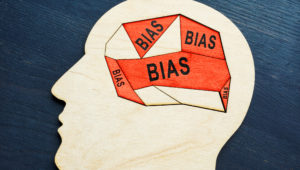Familiarity Bias: Are You Your Greatest Enemy?


Benjamin Graham, widely known as the “father of value investing,” once wrote, “The investor’s chief problem – and even his worst enemy – is likely to be himself.” All humans carry with them biases shaped by their backgrounds and experiences, which influence every decision they make. In this piece, we explore the origins, causes, and impacts that familiarity bias can have on investors, and offer a remedy to combat our own brains.
What is the Familiarity Bias?
Familiarity bias is the idea best illustrated by the old Wall Street adage: “Invest in what you know.” It is defined as the tendency for individuals to prefer what is familiar and to seek to avoid the unknown. While this tendency is present in all areas of life (such as the foods we choose to eat or the route we take on our morning commute), it is especially prevalent in the investment selection process.
Potential Causes of Familiarity Bias on Investors
A combination of factors contributes to the existence of familiarity bias in investors. These factors tend to fall into two main categories: institutional frictions and behavioral finance. Institutional frictions include inflation risk, currency risk, transaction costs, and asymmetric information. Behavioral finance issues include employees overinvesting in their own companies’ stock, overconfidence in forecasting returns on familiar assets, risk avoidance, patriotism, and social identification.
Institutional Frictions
- Inflation Risk: The first institutional barrier to investing in foreign assets is inflation risk. Hisham Foad writes, “An investor may prefer to invest in his or her own country’s assets if they are highly correlated with domestic inflation. By doing so, this investor is shielding wealth from an erosion of purchasing power caused by inflation.” However, localized shocks to a particular market or market sector present the greatest risk to purchasing power and the greatest argument for diversification.
- Currency Risk and Transaction Costs: Second, risks presented by the value of foreign currency may deter investors from being willing to pursue foreign investments. Foad found that familiarity bias has declined across Europe with the adoption of the euro. Similarly, transaction costs such as currency conversion fees or different tax rates may prohibit foreign investment.
- Asymmetric Information: A final institutional barrier is the asymmetric information presented by unfamiliar investment options. Language barriers and differences in accounting and reporting standards are two common challenges to understanding the information available from foreign markets. Due to the perceived lack of clarity, much of the investment activity in foreign markets is characterized by “return-chasing” behavior, with investors buying when returns are high and selling when returns are low. Foad argues, “that investors are forecasting returns based solely on past returns rather than using all available information suggests an information asymmetry.”
Behavioral Finance
In addition to institutional challenges, investors display a range of behavioral biases that tilt investment selection toward local assets.
- Overinvesting in Company Stock: The first, and arguably the most salient, is that employees tend to overinvest in their own companies’ stock. Research has shown that only 16% of employees believe that investing in company stock is riskier than investing in a broad market index. Foad writes that part of this bias stems from the fact that employers match employee retirement contributions with company stock, which is seen by most as an implicit endorsement of the stock.
- Overconfidence: A second, similar behavioral hurdle is overconfidence. Researchers continually show that investors display greater confidence in their forecasts of asset returns from their home countries than in their forecasts of foreign asset returns. Foad cites research by Strong and Xu: “[The researchers] survey mutual fund managers in Europe, Japan, and the United States. They find that managers are most optimistic about the performance of markets in their own countries, which is a prediction that cannot be correct for all of these managers.”
- Risk Avoidance: A third potential explanation for familiarity bias is the idea of risk avoidance. Particularly with more volatile markets, such as those categorized as “emerging markets,” investors weigh potential losses with greater importance than potential gains. Foad theorizes, “Even if only one country exhibits regret aversion, this may be enough to generate global home bias.” And particularly with the bull market performance between 2010 and 2020, American investors are reluctant to pass up any opportunity to benefit from domestic success.
- Patriotism and Social Identification:
- Other studies suggest that patriotism is a possible explanation for investing in domestic assets. It is possible that investors may derive some positive utility from investing in local assets despite monetary benefits from diversification.
- Investors may also derive utility from investing assets that are associated with countries or regions with which the investor positively identifies. The theory of social identification suggests that investors feel they can more easily identify potential risks of familiar assets because they recognize the risks of the country or region issuing those assets.
The Impact of Familiarity Bias on Investment Selection
There are many examples of the impact of familiarity bias on investment selection. The most notable relates to employees’ overinvestment in own-company stock. Consider these numbers: it is currently estimated that…
- Five million Americans have more than 60% of their retirement savings in company stock,
- Over 2 million Americans hold 40–60% of their retirement savings in company stock, and
- More than 3 million Americans hold 20–40% of their retirement savings in company stock.
When Enron declared bankruptcy in 2001, more than 60% of the assets held in Enron 401(k) accounts consisted of Enron stock. The same can be said for the experiences of Lehman Brothers or WorldCom employees: due to the perceived strength of one’s own employer, glaring risks have often been overlooked.
A more tangible example is portrayed by the International Monetary Fund’s Coordinated Portfolio Investment Survey for 2005. In nearly every country that was surveyed, citizens’ ownership of domestic equities greatly outweighed the country’s share of the world market. For instance, in the United States, 87.2% of investments were domestic, compared to a 43.1% share of the global market by the U.S. In Turkey, the difference was even greater: 99.9% of investors’ assets were of Turkish origin, while Turkey’s economy as a whole represented 0.3% of the global market. The disproportionate investment in domestic assets clearly represents a bias toward the familiar worldwide.
Diversification: The Ultimate Remedy
By now we hope it’s clear that familiarity bias limits individuals’ investment selections by reducing their exposures to unfamiliar investment options. Naturally, the best way to combat this is to ensure that your assets are properly diversified. Diversification reduces portfolio volatility (a.k.a., “risk”) in multiple ways.
- First, different types of investments perform differently at the same time.
- Second, investing in 10,000 stocks is much less risky than investing in 10 stocks, so diversification allows you to create a portfolio with a smaller risk than the combined risk of trading individual stocks.
- And third, different types of investments (and different geographical regions) are differently affected by the world’s political and economic events, creating various (and unpredictable) investing opportunities.
Another way to safeguard against the temptation to stick with what’s familiar is to make policy-based decisions. By relying on a uniform set of guidelines, individuals can make rational decisions rather than emotional ones. These policies or guidelines can be difficult to develop alone, which is why inviting in a trusted advisor can be a helpful next step. For example…
- At Yeske Buie, we rely on a thorough investment process that is supported by an understanding of the best available science. Our disciplined approach is then uniformly applied, allowing Clients to benefit from rational decision making no matter what the environment looks like.
- We also act as a resource for education and grounded thinking. We think every person can benefit from having a thinking partner who can help them identify their biases and educate them on how to overcome. Through education, financial planners can help individuals to be aware of the benefits of stepping beyond their comfort zones.
For all these reasons and more, a competent financial planner is a useful resource to combat the dangers of the familiarity bias. So the next time you find yourself enticed by the S&P 500, give us a call, and we can remind you that there’s a whole world of investments out there to explore.
Resources
- Foad, Hisham. “Familiarity Bias.” Behavioral Finance: Investors, Corporations, and Markets; Edited by H. Kent Baker & John R. Nofsinger; Hoboken, NJ; John Wiley & Sons, Inc.; 2010; pp. 277-291.
- Nofsinger, John R. “Familiarity Bias PART I: What Is It?” Psychology Today, 25 July 2008.
- Kumar, Sweeny. “Familiarity Bias And Their Effects On Investment Decisions Series – Part 9.” ValueWalk, 9 Aug. 2018.
- Graham, Benjamin. “Introduction.” The Intelligent Investor, 4th; Harper; 2006.
- Pankratyeva, Alexandra. “Familiarity Bias: How to Overcome the Fear of the Unfamiliar to Reach Your Investing Goals.” City A.M., 20 May 2019.
- Mitchell, Olivia S. and Utkus, Stephen P. (2003). “The Role of Company Stock in Defined Contribution Plans.” in The Pension Challenge: Risk Transfers and Retirement Income Security. Mitchell, Olivia S. and Kent Smetters (eds.) Oxford, UK: Oxford University Press.
- Bogan, Vicki. “The Different Faces of Familiarity Bias.” Hartford Funds, Feb. 2019.
- “Availability Heuristic.” Oxford Reference, 3 Aug. 2011.
- Tversky, Amos; Kahneman, Daniel (1973). “Availability: A heuristic for judging frequency and probability”. Cognitive Psychology. 5(2): 207–232.
- Hindsight Bias.
